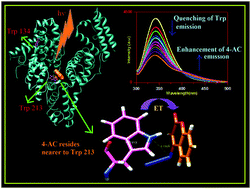Interaction of serum albumins with fluorescent ligand 4-azido coumarin: spectroscopic analysis and molecular docking studies†
Abstract
Steady state fluorescence and time resolved fluorescence studies at 298 K and low temperature phosphorescence (LTP) studies at 77 K of the interaction of bovine serum albumin (BSA) and human serum albumin (HSA) with ligand 4-azido-2H-chromen-2-one or 4-azidocoumarin (4-AC) have been carried out to visualize the location of the binding site and perturbation of the binding site of the tryptophan (Trp)/tyrosine (Tyr) of the protein(s) by monitoring the emission maxima of Trp residue(s) in proteins. The fluorescence quenching study of Trp estimated that the binding constant for both protein–ligand complexes is in the order of ∼106 with binding site 1. Perturbation in the secondary structures of serum albumins due to binding of 4-AC is also observed from circular dichroism (CD) studies. An energy transfer (ET) study further demonstrated that the non-radiative singlet–singlet ET that takes place from the Trp singlet states of proteins to the singlet state of ligands is greater in the case of BSA. This is supported by the distance and orientation of the donor–acceptor pair obtained from molecular docking studies. The molecular docking studies were also fruitfully exploited to understand the involvement of Trp213 in BSA and Trp214 in HSA in the ET process along with the perturbation of the residues around 5 Å from the ligand 4-AC. Phosphorescence spectra at 77 K of the Trp residues in the free proteins (BSA/HSA) and in the complexes of BSA/HSA have also been utilized to specify the role of Trp residues in ET and the binding process.



 Please wait while we load your content...
Please wait while we load your content...